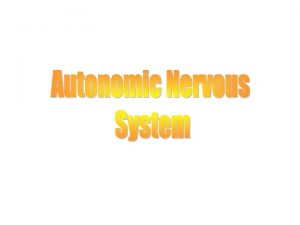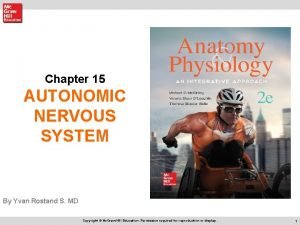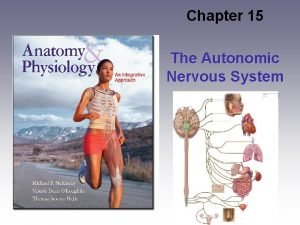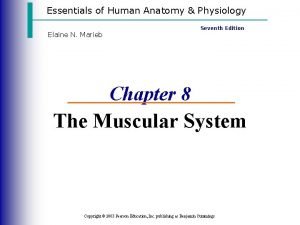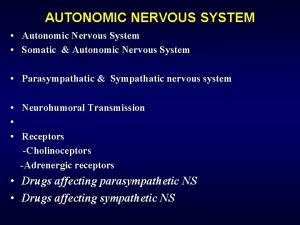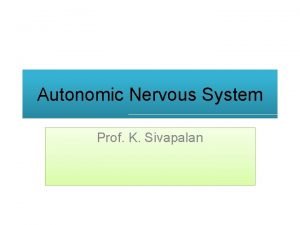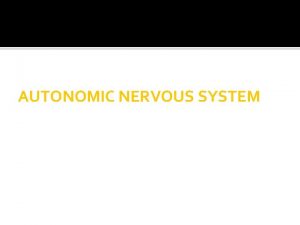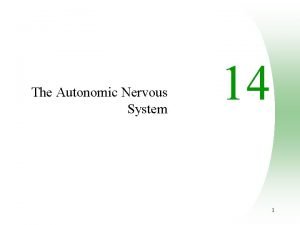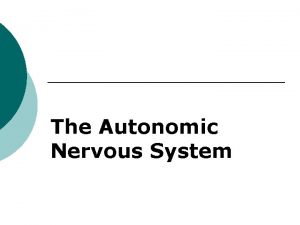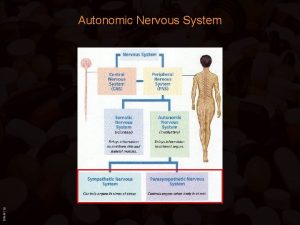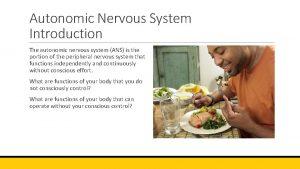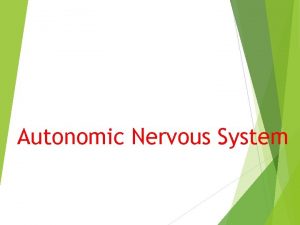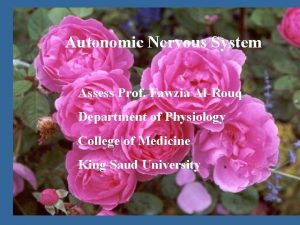I Overview II Anatomy III Physiology Autonomic Nervous
















- Slides: 16

I. Overview II. Anatomy III. Physiology Autonomic Nervous System 1

The Autonomic Nervous System § Regulate activity of smooth muscle, cardiac muscle & certain glands § Structures involved 1. general visceral afferent neurons 2. general visceral efferent neurons 3. integration center within the brain § Receives input from limbic system and other regions of the cerebrum 2

Autonomic versus Somatic NS § Somatic nervous system § consciously perceived sensations § excitation of skeletal muscle § one neuron connects CNS to organ § Autonomic nervous system § unconsciously perceived visceral sensations § involuntary inhibition or excitation of smooth muscle, cardiac muscle or glandular secretion § two neurons needed to connect CNS to organ § preganglionic and postganglionic neurons 3

Autonomic versus Somatic NS § Autonomic NS pathway is a 2 neuron pathway § Somatic NS pathway only contains one neuron. 4

Basic Anatomy of ANS § Preganglionic neuron § cell body in brain or spinal cord § axon is myelinated type B fiber that extends to autonomic ganglion § Postganglionic neuron § cell body lies outside the CNS in an autonomic ganglion § axon is unmyelinated type C fiber that terminates in a visceral effector 5

Divisions of the ANS § 2 major divisions 1. parasympathetic 2. sympathetic § Dual innervation § one speeds up organ § one slows down organ § Sympathetic NS increases heart rate § Parasympathetic NS decreases heart rate 6

I. Overview II. Anatomy A. Neurotransmitter III. Physiology Autonomic Nervous System 7

Sources of Dual Innervation 1. Sympathetic (thoracolumbar) division § preganglionic cell bodies in thoracic and first 2 lumbar segments of spinal cord 2. Parasympathetic (craniosacral) division § preganglionic cell bodies in nuclei of 4 cranial nerves and the sacral spinal cord 8

ANS Neurotransmitters § Classified as either cholinergic or adrenergic neurons based upon the neurotransmitter released § Adrenergic § Cholinergic 19

Parasympathetic § Cholinergic neurons release acetylcholine from preganglionic neurons & from parasympathetic postganglionic neurons § Action: Excites or inhibits depending upon receptor type and organ involved § Receptor: § Nicotinic receptors are found on dendrites & cell bodies of autonomic NS cells and at NMJ § Muscarinic receptors are found on plasma membranes of all parasympathetic effectors 20

Sympathetic § Adrenergic neurons release norepinephrine (NE) from postganglionic sympathetic neurons only § Action: Excites or inhibits organs depending on receptors § Receptor: § Alpha 1 and Beta 1 receptors produce excitation § Alpha 2 and Beta 2 receptors cause inhibition § Beta 3 receptors (brown fat) increase thermogenesis § NE lingers at the synapse until enzymatically inactivated by monoamine oxidase (MAO) or catechol-O-methyltransferase 21 (COMT)

I. Overview II. Anatomy III. Physiology A. Hypothalamus B. Sympathetic C. Parasympathetic Autonomic Nervous System 22

Physiological Effects of the ANS § Some organs have only sympathetic innervation § sweat glands, adrenal medulla, arrector pili mm & many blood vessels § controlled by regulation of the “tone” of the sympathetic system § Most body organs receive dual innervation § innervation by both sympathetic & parasympathetic § Hypothalamus regulates balance (tone) between sympathetic and parasympathetic activity levels Hypothalamus 23

Sympathetic Responses § Dominance by the sympathetic system is caused by physical or emotional stress -- “E situations” § emergency, embarrassment, excitement, exercise § Alarm reaction = flight or fight response § dilation of pupils § increase of heart rate, force of contraction & BP § decrease in blood flow to nonessential organs § increase in blood flow to skeletal & cardiac muscle § airways dilate & respiratory rate increases § blood glucose level increase § Long lasting due to lingering of NE in synaptic gap and release of norepinephrine by the adrenal gland 24

Parasympathetic Responses § Enhance “rest-and-digest” activities § Mechanisms that help conserve and restore body energy during times of rest § Normally dominate over sympathetic impulses § SLUDD type responses = salivation, lacrimation, urination, digestion & defecation § 3 “decreases”--- decreased HR, diameter of airways and diameter of pupil § Paradoxical fear when there is no escape route or no way to win § causes massive activation of parasympathetic division § loss of control over urination and defecation 25

Comparison Sympathetic Increase HR Constriction Dilation Parasympathetic CVS: Heart CVS: Veins Resp: Bronchioles GIT: Stomach and Intestines GIT: Liver GIT: Gall Bladder UT: Kidney UT: Urinary Bladder Ejaculation Repro: Sex Organs Increase motility Glycogenesis Contraction Diuresis Contraction/ urination Erection 26
 Slidetodoc
Slidetodoc Autonomic nervous system consists of
Autonomic nervous system consists of The autonomic nervous system controls
The autonomic nervous system controls Somatic and autonomic nervous system
Somatic and autonomic nervous system Nerve ganglia
Nerve ganglia Ans
Ans Ganglion on spine
Ganglion on spine Autonomic nervous system
Autonomic nervous system Somatic nervous system
Somatic nervous system Autonomic nervous system
Autonomic nervous system Neuronal pool
Neuronal pool Nervous
Nervous Neuronal pools are collections of
Neuronal pools are collections of Hamlet act iii scene iii
Hamlet act iii scene iii Anatomy and physiology
Anatomy and physiology Structure anatomy and physiology in agriculture
Structure anatomy and physiology in agriculture The speed at which the body consumes energy
The speed at which the body consumes energy


